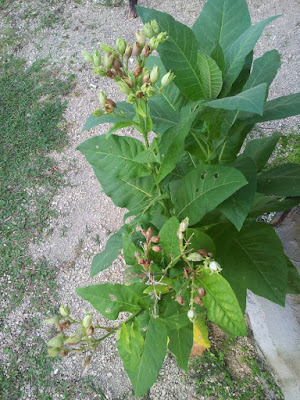CHAMORRO WOMAN SMOKING A CIGAR
Early 1800s
Our people were really into tobacco in the 1700 and 1800s.
Tobacco was so prized by our people that they were willing to be paid with tobacco. The Spanish government often did just that; pay government workers with tobacco.
Listen to a French visitor in 1828, Jules S.C. Dumont d'Urville, describe his visit to a home in Mongmong,
"Some days later I visited the village of Mongmong.... Some corn, rice and tobacco - the basic crops of the land - were grown there. I went to pay a visit to the highest official in the place, the gobernadorcillo or kind of mayor. I was next presented to his wife, a formidable-looking woman... Without taking her cigar out of her mouth, she replied to the greeting that I had learned earlier. When I said, "Ave María purísima," the woman mumbled, without lifting her eyes a bit, "Sin pecado concebida."
The mayor's wife, just like the woman pictured above, had a cigar in her mouth. In describing the women of Hagåtña, Dumont d'Urville said,
"The women wore nothing on their heads or on their feet, it is true, but they were decently clothed in a skirt and a jacket, with cigars in their mouths...."
SPANISH GOVERNOR'S TOBACCO FIELD IN HAGÅTÑA
Early 1800s
One of the reasons why Chamorros in the old days were so fond of tobacco is because it was successfully and easily grown here.
It was brought to the Marianas during Spanish times, probably very early after the arrival of Sanvitores in 1668. Our tropical climate made it easy for the plant to grow here. Nearly everyone who grew anything grew even a little tobacco. Rose Freycinet, wife of the French explorer, described in 1819 how the spaces in between the houses in Hagåtña were used to grow a little tobacco.
For bigger plantings of tobacco, the American William Safford, living on Guam between 1899 and 1900, said that the best places for growing tobacco were Santa Rosa, Yigo, Fina'guåyok and Matåguak in the north and Yoña in the south.
GUAM TOBACCO PATCH
Early 1900s
Although tobacco took easily to Guam's climate and soil, tobacco was not, in fact, "easy" to grow. Great care had to be taken to grow the seedlings in beds before transferring them to the soil, without damaging the roots. Seedlings had to be planted at the right time of year, August and September. In October and November, the seedlings are transferred to nurseries and then to the fields from December to February.
Now, as the tobacco plants start to grow in the earth, the farmer must weed the area and keep the tobacco leaves free of the sphinx moth whose larvae feeds on the leaves. The tobacco plants can't have too much sun, so coconut palm fronds are stuck in the ground around the tobacco and bent forward to touch each other, forming a protective canopy over the tobacco plants. Side branches are plucked off so that more of the nutrients could go to the better leaves.
When the plant is ready for harvesting, the whole plant is cut as close to the ground as possible and the leaves allowed to wither on the stem. Then the leaves are taken off the stem and hung to dry, usually two or three plants in a bunch. The tobacco is simply rolled, often ten leaves in a roll, called a paliyo, and fastened together by strings made of pineapple (piña) or agave fiber (lirio de palo).
CHAMORRO BIHA SMOKING A PIPE
Visitors said smoking was bigger among the women more than the men.
Who enjoyed the tobacco? Almost everybody! They rolled it into cigars or chewed it with pugua' (betel nut), pupulo (pepper leaf) and åfok (lime powder). Safford says that only the higher class women refrained from smoking or chewing tobacco, or at least didn't use tobacco in front of others. So fond were the people of local tobacco that they would buy imported tobacco only if the local supply ran out.
Speaking of the local supply, here's an idea how much tobacco was grown on Guam before the war. In 1919, 81 acres of land were dedicated to tobacco growing. That's not much when you consider that 2,173 acres were used for growing corn in the same year. But tobacco still outranked sugar, to which only 13 acres on island were used for growing. A little over 36,000 pounds of tobacco were harvested on Guam in 1919.
LADY SMOKING IN FRONT OF CHILD
Early 1800s
THE DECLINE OF TOBACCO GROWING
Still, a few people grow tobacco in small quantities on Guam to this day.
MODERN DAY GUAM-GROWN YOUNG TOBACCO
(courtesy of Raph Unpingco)
CHAMORRO TERMS
TOBACCO = CHUPA
CIGAR = CHIGÅLO
CIGARETTE = SIGARIYO
CHEWING TOBACCO = AMÅSKA
PIPE = CHIGÅNDO
PIPE = CHIGÅNDO
HOME GROWN TOBACCO







No comments:
Post a Comment